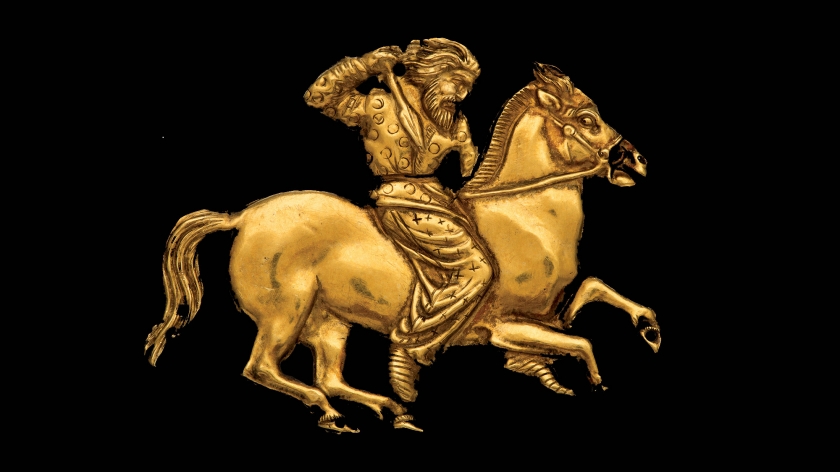The article below is the Introduction section of the textbook “Warriors of Ancient Siberia” (edited by St John Simpson of the British Museum and Svetlana Pankova of the State Hermitage Museum) written for the BP Exhibition organized with the State Hermitage Museum, St Petersburg, Russia, the British Museum and Thames & Hudson. The Introduction is also available for download at Academia.edu … For more information on this book consult: Amazon.com and Thames & Hudson.
=====================================================================================
The Scythian nomads controlled a vast area stretching from the edge of northern China to the northern Black Sea region. Originating in southern Siberia, they dominated the Eurasian steppe for centuries until they were displaced by other Eurasian nomad tribes at the beginning of the second century bc. Although the Greeks referred to them as ‘barbarians’, this term was applied to all non-Greeks, and the nomads developed a rich material culture with a strong visual language involving fierce contorted animal designs known as ‘Animal Style’ art. This is found on the decorated ends of torcs, bangles and dagger pommels, gold and bronze belt buckles, saddle covers and even body tattoos. The Scythians were skilled at working metals and softer materials such as bone, horn and wood, which were sometimes highlighted with paint, appliqués or colourful sheet-metal overlays; this allowed sparing use of precious metal yet the appearance was spectacularly like solid metal. As pastoral nomads they kept large herds and had plentiful supplies of leather, wool and hair, which not only provided the basis for clothing and soft furnishings but were also easily traded resources in constant demand from their sedentary neighbours. There was regular contact with these: the fifth-century bc historian Herodotus met Scythians in Greek colonies on the northern Black Sea coast; Greek and Assyrian histories record that they fought their way into Anatolia; and they proved a constant threat to the Achaemenid Persian Empire on its eastern frontier in Central Asia. These contacts, whether through conflict, trade or marriage, explain why Achaemenid silver, gold and even carpets ended up in nomad tombs, how Scythian-related goldwork forms part of the Oxus Treasure found near the river Amu darya (Oxus) in its eastern province of Bactria, and why many design motifs are shared by both the Scythian and Achaemenid worlds.
Ancient authors described these peoples where they encountered them at the fringes, but one of the regions where this early nomadic lifestyle first developed was Tuva (fig. 1), at the junction of the Siberian taiga and the Altai-Sayan mountains. It is here that the earliest manifestations of the so-called ‘Scythian triad’ of weapons, horse harness and Animal Style art emerges in the ninth and eighth centuries bc, and archaeological excavations at Arzhan reveal burials of elite individuals interred with their wives or concubines, attendants, and horses. This area is at the heart of southern Siberia and connected by a continuous corridor of grassy pasture to northern China and the Black Sea region. This biome (ecological area) is wider than the vast empire of the Achaemenids, which united the Near East between the sixth and fourth centuries bc, and the Scythians outlasted them, as they had their Late Assyrian and Median predecessors. The Scythians were finally overwhelmed and dissipated by later tribal groups. Roman and Byzantine authors continued to refer to their nomad successors in the Black Sea region and Central Asia as Scythians, but the cultures were changing, and Iranian was replaced by Turkic languages. China was now the dominant political power and there were stronger links with that culture than previously. Deep in the resource-rich but isolated Minusinsk basin, the so-called Tashtyk culture developed during the early centuries ad; this is the focus of the conclusion to the exhibition.
The story behind the objects presented here begins with chance finds made deep in southern Siberia during the eighteenth century. The Russian conquest of Siberia had begun in 1581/82 during the reign of Ivan IV, ‘the Terrible’ (1530–1584), with the defeat of the Tatar khan, Khimchum, by the Cossack commander Yermak. The numerous local tribes were required to pay heavy tribute in furs, a process known as the yassak.

Fig. 1: Landscape view showing Scythian burial mounds in Tuva, southern Siberia.
Tsar Peter I, ‘the Great’ (1672–1725), began sending scientific expeditions to the region; it was during one of these that the strait separating Siberia from Alaska was discovered in 1728 and named after its finder, Vitus Bering (1681–1741). The exploration of Siberia was marked by amazing antiquarian discoveries as large burial mounds (kurgans) attracted the attention of engineers and grave robbers (bugrovshchiki). News of the discovery of fantastic gold ornaments in completely unfamiliar styles soon reached St Petersburg as a collection formed by one Demidov was presented to Peter in 1715. The Tsar issued an edict that any such finds, especially those ‘that are very old and uncommon’, should be sent to St Petersburg, and ordered that drawings be made ‘of everything that is found’. After his death they were transferred to the Kunstkamera (‘Cabinet of Curiosities’), which he had founded in 1714, the first museum in the country. In 1690 the Dutchman Nicolaas Witsen published the first map of Siberia, and two years later the first edition of his account entitled Noord en Oost Tartarye. In the same year one Andrei Lyzlov, said to be either a priest from Smolensk or a courtier from Moscow, wrote an account entitled History of the Scythians, and there was considerable academic interest in Russia into how these finds connected with the ancestral origins of the Slavs and other peoples, and therefore with the early formation of Russia itself (fig. 2).
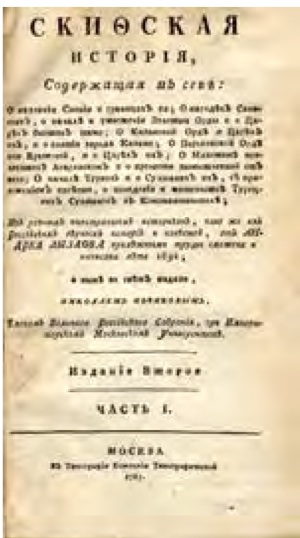
Fig.2: Frontispiece of the History of the Scythians by A. Lyzlov. London Library.
During the second half of the eighteenth century, in the reign of Catherine II, ‘the Great’ (1729–1796), Russia occupied the northern coast of the Black Sea from the mouth of the river Dniester to the area around Kuban, and achieved its aim of obtaining a warm-water port with access to the Mediterranean (fig. 3).
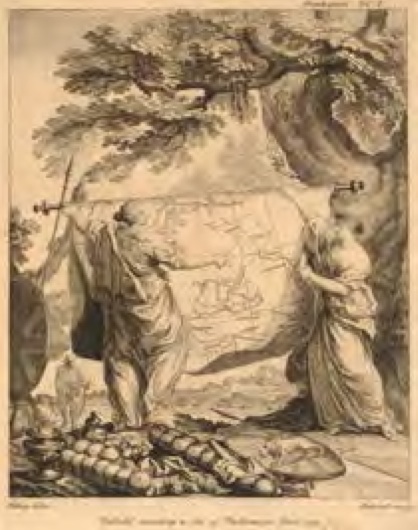
Fig.3: Print showing the advance of Russia towards the Black Sea during the reign of Catherine II.
Simon François Ravenet I after Nicholas Blakey, 1753 (H. 22.4, W. 17.1 cm, British Museum, London, 1978, U.1663).
As part of its so-called Greek Project – according to which Russia intended to oust the Turks from Europe and as self-styled heirs of the Byzantine Empire found an Empire of Constantinople – cities were given Greek names. In 1787 Catherine visited the area, and antiquarian travellers began to record sites and note the presence of ancient Greek inscriptions. The first kurgan was excavated in 1763 by General Alexey Melgunov (1722–1788), the governor of the Novorossiisk province. It was found to be a seventh- century bc Scythian tomb and proved accounts that the Scythians were active in this region from this early date. Within a year Herodotus’ Histories were translated into Russian for the first time, and a copy of a gold scabbard found by Melgunov was presented to the British Museum (fig. 4).
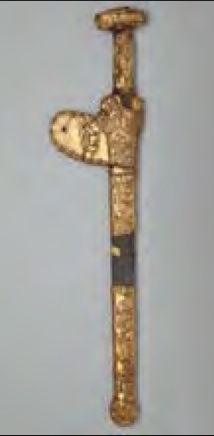
Fig.4: The Scythian gold scabbard known as the Melgunov scabbard. Seventh century BC (L. 60 cm, State Hermitage Museum, St Petersburg, Dn 1763 1-19, 20).
Other generals excavated a burial mound near the Black Sea port of Phanagoria, and initiated excavations at Olbia and Kerch at the eastern end of the Crimean peninsula. In 1830 a large kurgan at Kul’ Oba, near Kerch, began to be quarried for construction. Excavations immediately followed under the direction of Paul Du Brux, a French antiquarian who owned a private museum and was the chief customs officer in Kerch, and Ivan Stempkovsky, the governor of Kerch. An intact stone tomb measuring 20 sq. m was found to contain the bodies of what are believed to be a Scythian king and queen with numerous gold objects, a groom with a horse, armour, cauldrons, amphorae and drinking vessels. These objects were immediately acquired by the Imperial Hermitage and formed the beginning of the museum’s archaeological collection. On 3 June 1837 an imperial decree stated that the Ministry of Internal Affairs be informed with ‘the appropriate accuracy and detail’ of all architectural finds, and the minister of internal affairs, Count Lev Perovsky, directed the first excavations of royal Scythian burial mounds in this region during the early 1850s. Further excavations, mainly on the Kerch and Taman peninsulas, were generously funded by the Ministry of the Imperial Court, and the finds inspired arts and crafts (fig. 5) and even the interior decor of the New Hermitage, which was intended as a museum and completed in 1851. The collection from the Kunstkamera was transferred to the Hermitage, where it was, and still is, known as ‘Peter I’s Siberian Collection’. In 1854 an album was published containing the most important finds and an Archaeological Commission was founded in 1859 with the following remit:
(1) the search for antiquities, primarily those relating to Russian history and the life of the peoples who once inhabited the territory that is now occupied by Russia; (2) the collection of information on national and other antiquities located within the state; (3) the scientific study and evaluation of the antiquities discovered.1
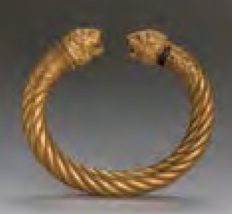
Fig.5: A gold Scythian bracelet found in 1869 in the fourth-century bc burial mound of Temir-Gora, near Kerch in the northern Black Sea region. Bracelets like this inspired Russian jewelers to make and exhibit copies, and these were copied again by continental European and English firms (State Hermitage Museum, St Petersburg, TG-6).
Royal burial mounds and major sites continued to be the focus in the northern Black Sea region, and large numbers were explored (figs 6–7). The 20-m-high Alexandropol burial mound (also known as the Meadow Grave) was the first to be completely excavated, though most of the finds were lost during bombing in 1941. Other mounds were excavated between 1859 and 1863 by the historian Ivan Zabelin (1820–1908), including the Great Twin Barrow on the Taman peninsula and the famous burial mound of Chertomlyk. The latter stood 20 m high and up to 120 m across, with a massive outer stone wall and a complex tomb with side chambers at the centre: although the central chamber had been robbed in antiquity, valuable finds had been overlooked, and the side rooms still contained the remains of female and warrior burials with rich grave goods.
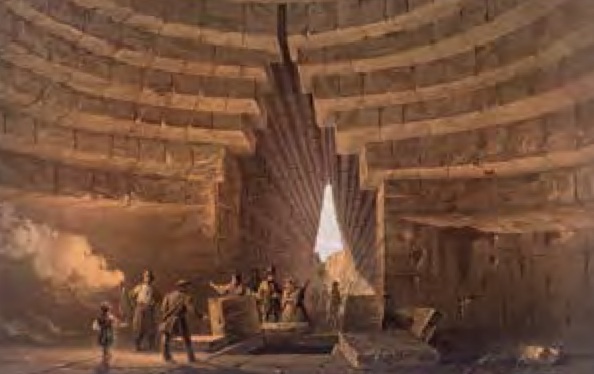
Fig.6: The interior of a large burial mound known as the ‘Tomb of Mithridates’ near the Lazaretto of Kerch; Edmund Walker in 1856, after a view by Carlo Bossoli, H. 18.4, W. 28.5 cm; British Museum, London, 1982,U.687 Donated by Westminster City Council)
The exact find-spots of the earliest discoveries made during Peter’s reign remain unclear but are known to have been at different sites between the Ural and Altai mountain ranges in southern Siberia; this was supported by the discovery of typical Scythian objects during excavations in 1865 by academician V. V. Radlov at two large burial mounds (Berel, Katanda) in the Altai region. In 1889 the Archaeological Commission was given exclusive excavation rights and it was agreed that, while the most important finds should be sent to the Hermitage, other pieces could be distributed to local museums. The academician and professor at St Petersburg University Nikolai Veselovsky (1848–1918) led a series of highly successful expeditions to the northern Caucasus and Black Sea region, where he excavated the major burial mounds Oguz (1891–4), Kostromskaya (1897), Kelermes (1904, 1908), Ulsky (1908–10) and Solokha (1912–13); it was in this last mound that he found some of the most spectacular examples of Greco-Scythian goldworking, including a comb topped with a battle scene, a golden phiale (a shallow drinking vessel) with animal designs, an overlay for a bow case with a scene from a Scythian epic and a silver cup depicting a Scythian hunting scene (see Chapter 1).2
Fig.7: Ruins of ancient Chersonesos. Jonathan Needham in 1856, after a view by Carlo Bossoli H. 18.8, W. 28.3 cm (British Museum, London, 1982,U.699 Donated by Westminster City Council).
In October 1917 Russia was convulsed by revolution and the Hermitage was stormed. Huge social changes began to be implemented, and in the first few months the Soviet authorities established a Committee of
the North in order to protect twenty-six ethnic groups in Siberia who were considered at greatest risk: they were exempted from military conscription and taxation, offered basic social amenities, and an attempt was made to teach in native tongues, acknowledging their nomadic existence by schooling in tents. There was also a huge increase in the number of local history societies and museums across the country. However, these measures were short-lived and the individuals concerned were soon accused of supporting local patriotism over national interests.3 In 1929/30 communist collectivization of food production began to be imposed across Russia, nomads were settled, owners of large herds were deported, shamans were outlawed and children were put into Russian boarding schools. It was immediately afterwards, in 1931,
that a detailed census was carried out, which formed the basis for a landmark study by S. Vainshtein of the disappearing nomad economy of the Tuva region.4 During the 1960s local collective farms reorganized into larger enterprises, and the integration of local and Russian populations increased.
In the meantime, on 18 April 1919 the Imperial Archaeological Commission had been dissolved and replaced by the Institute for the History of Material Culture (Lenin personally added the word ‘history’ to its founding edict), and money poured into archaeological projects from the 1930s onwards.5
The Hermitage created three new departments – one that became the Oriental Department in 1920, the Department of Prehistoric Societies (now the Department of the Archaeology of Eastern Europe and Siberia) in 1931, and the Department of the History of Russian Culture in 1941 – and it enjoyed an almost unbroken sequence of directors who were themselves archaeologists. During this period archaeology became politicized and seen as an opportunity for the Soviet authorities to find evidence for Marx’s classification of society into developmental stages, beginning from a pre-class stage through stages of slave-owning, feudalism and capitalism before attaining a classless society with communism as its climax. The superiority of Slavs over Germanic peoples was emphasized while Russia and Germany were at war; cases of ethnogenesis, or the emergence of ethnic groups, were sought within the Soviet Union, and the definition of archaeological cultures and their relationship to linguistic boundaries and peoples were debated.
The origins of the Scythians continued to attract different views. Some Russian scholars saw them as originating in the northern Black Sea region, in the area where they were described by Herodotus. Academician Mikhail Rostovtzeff (1870–1952) interpreted them as a feudal military power, and was the first to begin defining them as an archaeological culture on the grounds of the standard appearance of their burial mounds and other features.6 The Moscow professor Boris Grakov (1899–1970) was the first to excavate large numbers of simple burial mounds belonging to ‘the common people’, in contrast with the previous focus on ‘royal’ mounds; he also thoroughly explored a hill fort at Kamenka, interpreted the Scythians’ social development in Marxist terms as a stage of transition from military democracy to a slave-owning society, and saw the spread of the so-called ‘Scythian triad’ as evidence for the Scythianization of the indigenous forest-steppe population.7 The coexistence of two different Scythian cultures, on the steppe and in the forest-steppe, was instead advocated by Mikhail Artamonov (1898–1972), who later became director of the Hermitage. He wrote extensively on how much Scythian art showed Near Eastern inspiration and emphasized that the Scythians were Iranians rather than Slavs.8 His successor, B. B. Piotrovsky (1908–1990), went on to find dramatic evidence for Scythian military activity in the Caucasus during his excavations of an Urartian fortress at Karmir Blur in Armenia, which had been violently sacked, but distinguishing between objects made by Scythians and the Cimmerians, their early northern rivals in the northern Black Sea region, proved to be a long-running issue.
These and other debates rumbled on for decades, and as late as 1979 the head of Soviet archaeology for thirty years, Boris Rybakov (1908–2001), stated in a book entitled The Scythians of Herodotus that the land- tilling Scythian tribes in the northern Black Sea region were the possible ancestors of later Slav tribes, making a tenuous philological link between the Skolotoi (a name given by Herodotus for other Scythian tribes) and the Sklavins (the Greek for Slavs). However, during the 1920s an ethnological expedition began work in Altai and had already challenged the idea that Scythians originated in the Black Sea region. In 1927 the Russian Museum in Leningrad excavated another burial mound in the central Altai region at Shibe and found it to be very similar to those previously excavated by Radlov. Three years earlier Sergey Rudenko (1885–1969), head of the ethnography section of the Russian Museum in Leningrad, had discovered a group of burial mounds at Pazyryk, and he excavated the first in 1929 with his Siberian-born student Mikhail Gryaznov (1902–1984). Conditions were tough. There were no roads or nearby food supplies, the team had to employ children as labourers, horses were used to drag away the heaviest boulders and water had to be boiled by the side of the trench to melt the permafrost (pp. 98–99; fig. 8).
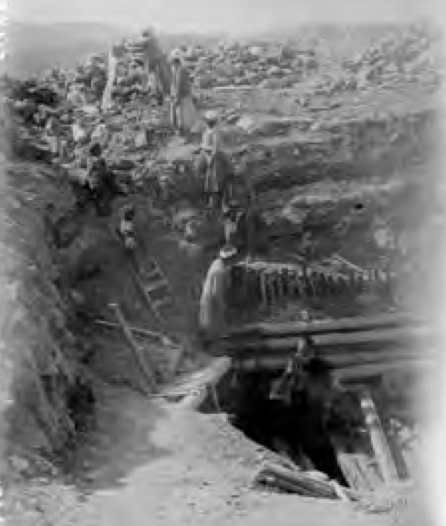
Fig 8: Excavations in progress at the burial mound of Pazyryk-2 in 1948 (Archive of the Institute for the History of Material Culture, St Petersburg, I-32719).
In the meantime there were serious political problems in Leningrad as Stalin began the ‘Great Terror’ in 1934 with a purge of the intelligentsia as well as the political and military command. A witch-hunt was instigated against individuals who had used ‘bourgeois’ classifications, such as Bronze or Iron Age; ‘archaeology’ was replaced by ‘Marxist history of material culture’; over fifty curators at the Hermitage were deported or executed; and the leading Leningrad archaeologist Aleksandr Miller (1875–1935) was sent to Siberia for ‘writing long drawn-out reports on things he had excavated’, as this was condemned as ‘empiricism’.9 Moreover, collaboration with Russians working abroad, particularly in Germany, was banned and scholars were arrested as spies. Rudenko himself was arrested in 1933, accused of pointless investigations and ethnographic idealism, and spent years working in the northern labour camps (although ironically he was promoted because of his knowledge of hydrology and proved invaluable for his ‘ice forecasts’ during the Soviet supply of the besieged city of Leningrad across the frozen Lake Ladoga in the Second World War). His colleague Gryaznov was also charged with being an underground fascist working with Ukrainian and Russian nationalists, and was exiled internally for three years. In 1941 the Pazyryk collection was transferred from the Russian Museum to the Hermitage, but from September that year until January 1944 Leningrad was besieged by the German army, and it was not until 1947 that Rudenko and Gryaznov returned to Pazyryk, where over three more seasons they excavated the four remaining mounds under the auspices of the Institute of the History of Material Culture, which retains the archives, and the Hermitage, where the finds were deposited.
Although all the tombs had been robbed and there was therefore virtually nothing of intrinsic value remaining, the frozen conditions stemming from the percolation of water into the tomb promoted exceptional preservation of the organic remains, which revolutionized the appreciation of Scythian everyday life.10
Rudenko and Gryaznov shared the same building but parted academic ways and never spoke to each other again. Rudenko established a laboratory of archaeological technology in his institute and championed the application of natural sciences in archaeology. Gryaznov went on to head the Central Asia and Caucasus section: he maintained that archaeological cultures were stages or phases in local development rather than evidence of separate cultures, but his excavations at the early Scythian burial mound at Arzhan-1 overturned earlier views and showed that what was now known as the ‘Scythian triad’ already existed in the Tuva region by the late ninth or early eighth century bc, and that this was not a development of the Black Sea or Iran.11 Although there are similarities in the material culture and pastoral economy, there are also differences in detail of dress, burial customs, pottery and other aspects of lifestyle, and it is better to regard these as evidence for a shifting confederation of powerful tribes united within a Scythian cultural world.
Archaeological research on Scythians is continuing, with excavations each year across the Eurasian steppe, extending from Mongolia through Kazakhstan and Russia to Ukraine. A Ukrainian–German expedition returned to Chertomlyk between 1979 and 1986 and added considerable new evidence for how the mound was built.12 Between 2001 and 2004 a Russian– German expedition directed by K. Chugunov, H. Parzinger and A. Nagler fully excavated another burial mound at Arzhan in Tuva, and proved that the Black Sea tradition of interring large quantities of gold did extend to this region.13 During the 1990s archaeologists from Novosibirsk excavated more ‘frozen mummies’ at unrobbed burial mounds on the Ukok plateau, next to the Chinese border (fig. 9), and in neighbouring Kazakhstan the burial mound of Berel-11 was explored by a Kazakh–French expedition and shown to belong to the same culture as Pazyryk (see pp. 100–103). Concerns that global warming will lead to the melting of the permafrost, which has been the sole reason why these tombs have yielded such exceptional finds, means that these excavations are as much rescue as research.14 Other expeditions are recording the rich rock art traditions, and large areas that include later period sites such as Oglakhty have been designated nature reserves (see p. 342).
Collaborative research and the use of scientific techniques are now common: dendrochronological and radiocarbon dates are refining the dating of sites,15 advances in bioarchaeology are adding information on the genetics, diet and health of both horse and human populations,16 and detailed analyses of metalwork and textiles are throwing new light on technologies.17 This book of the exhibition is intended to show some of these results and how far we have progressed beyond the writings of Herodotus and the first antiquarian discoveries during the reign of Peter the Great.18
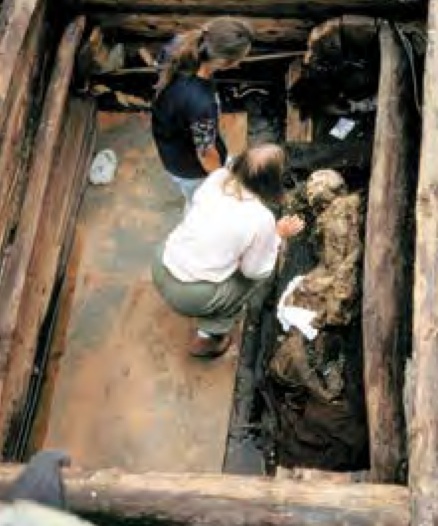
Fig.9: Excavations of a ‘frozen mummy’ at Ak-Alakha-3 on the Ukok plateau.

